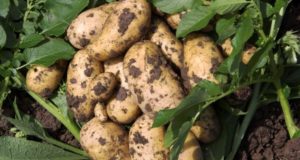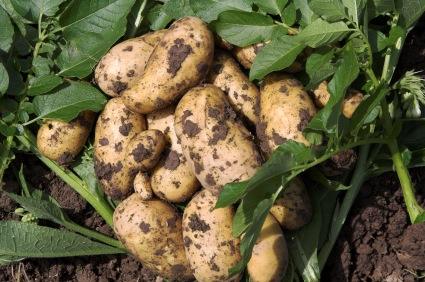 “Root vegetable” is a loose term that describes crops with edible root systems. These include crops like potatoes, garlic, turnips, and carrots, as well as more uncommon foods like parsnips, celeriac, and daikon. Root vegetables are important crops in the tropics as well, and include exotic foods like cassava and taro. Many of these root veggies have the added bonus of edible and nutritious green tops. Some root crops, like the potato, also have ornamental value and make attractive groundcovers. Hardy, compact, and often fast growing, root vegetables are a nutritious and productive addition to any garden.
“Root vegetable” is a loose term that describes crops with edible root systems. These include crops like potatoes, garlic, turnips, and carrots, as well as more uncommon foods like parsnips, celeriac, and daikon. Root vegetables are important crops in the tropics as well, and include exotic foods like cassava and taro. Many of these root veggies have the added bonus of edible and nutritious green tops. Some root crops, like the potato, also have ornamental value and make attractive groundcovers. Hardy, compact, and often fast growing, root vegetables are a nutritious and productive addition to any garden.
Popular Root Vegetables
There is a wide variety of plants with edible root systems all over the world. Below are some of the most popular root vegetables for the garden. For those looking for more variety, many hardy and unique heirloom varieties are available for all of the root crops listed.
Potatoes: Originating in South America, the potato is a starchy root that has become a vital food crop all over the world. It is packed with nutrients and filled with energy-giving carbohydrates. In fact, humans can subsist almost entirely off of potatoes, with only some dairy foods needed to provide vitamins A and D – the only nutrients that potatoes lack. In this way, potatoes are superior to other staples like wheat and corn.
Carrots: Crisp and tasty, carrots are one of the most popular root vegetables. As a kid, there was just nothing more satisfying than the sweet crunch of a newly harvested carrot on a summer day. Wild species of this ancient food may have been eaten by people thousands of years ago. Carrots are excellent for fall planting – they become sweeter as the ground begins to cool. For some fun variety in the garden, try planting colorful cultivars like Cosmic Purple, Lunar White, and Amarillo.
Turnips/Rutabagas: Turnips and the larger rutabagas (a cross between a turnip and a cabbage) are fast-growing root vegetables that thrive in cool temperatures. With edible leafy tops, turnips can taste anywhere from cool to spicy and are great eaten raw or cooked. Reaching maturity after only thirty to sixty days, these little veggies are among the fastest-growing crops and best performers in colder climates.
Radishes: Turnips may be fast growers, but the fastest-growing vegetable title belongs to the radish, which can reach maturity in only a few weeks. Closely related to turnips, radishes are a popular choice for gardens across the country. They are compact, nutritious, and easy to both grow and harvest in multiple climates.
Onions/garlic: Onions, along with their relatives garlic, chives, and shallots, are compact, flavorful bulbs that are indispensable to cuisine worldwide. They are also very easy to grow, with dozens of varieties available to thrive in just about any climate. Unlike most root vegetables, onions and garlic like to grow in slightly acidic soil. These root vegetables come in a wide variety of sizes, colors, and tastes, as well as a wide range of harvest times. Onions and garlic can also be planted as companion plants to other vegetables in the garden, acting as a pungent deterrent to hungry pests.
Beets: Beets are colorful, tasty roots that add more nutrition and a touch of sweetness to a garden. Like the turnip, both the leaves and the root of beets are edible and packed with vitamin C and beta-carotene. Beets are well known for their bright red juice, but heirloom varieties can be orange, yellow, or even white. Like many root vegetables, beets mature quickly.
Sweet potatoes: For those living in the southern U.S., sweet potatoes are a unique, nutritious, and very tasty root vegetable. Although orange is the most popular color, sweet potato tubers can come in white, purple, and yellow. These root vegetables are actually related to the morning glory and have a sprawling growth habit, though there are also bush varieties available. Unlike the potato, sweet potatoes also have edible shoots. This is a tender, warm-weather crop that needs at least 100 days of frost-free weather. For those able to grow it, however, sweet potato brings many benefits to the garden. It is an excellent source of beta-carotene and vitamin A.
Get ready for planting season with heirloom seeds from Heirloom Solutions
Benefits
- Nutrition: For the amount of space they take up, root vegetables produce a lot of nutritious food, packed with energy and minerals. Some can even be grown to provide nutritious fodder for livestock during the winter.
- Carbohydrates: Root crops store their energy in the form of starch, a type of carbohydrate. For active lifestyles, or if food is scarce, this starch is an excellent source of energy.
- Beta Carotene & other nutrients: All root vegetables are packed with vitamins and minerals. They are good sources of vitamins A, C, B6 ,and K, as well as potassium, beta-carotene, fiber, and many more.
- Easy to Grow. In general, root vegetables are hardy plants that are virtually maintenance-free – no need to prune or train them up a trellis.
- Easy to store: When properly harvested and stored, root vegetables have a long shelf life and can last for several months.
How To Grow Root Vegetables
Root vegetables are somewhat different from other common garden veggies. Grown for their tubers and bulbs beneath the ground, these crops need ideal soil conditions and protection from soil-dwelling pests.
For those wishing to escape heavy digging during harvest, growing root crops in containers is a simple and easy option. Large bags filled with soil, for example, are becoming a popular way to grow potatoes on decks and patios.
Soil Prep: Almost all root crops need loose, almost fluffy, composted soil with good drainage. In general, these vegetables don’t do well in acidic soils. When preparing soil for root crops, deeply till in the compost and fertilizer, and adjust the pH if needed.
Light: Root vegetables generally need bright sunlight. Even though we don’t always eat the leafy greens above the soil, it’s worth remembering that the amount of food stored in the plant’s tubers is directly influenced by the amount of sunlight it receives.
Watering: Tubers are prone to waterlogging, and even a short time of sitting in soggy soil can completely ruin an entire crop. To encourage healthy root growth, water deeply once or twice a week rather than water small amounts frequently.
Potential Problems: All garden plants are susceptible to disease, and root veggies are no exception. Blights, rots, and other diseases can decimate a crop. Be sure to acquire only certified disease-free roots for planting, and only grow varieties that thrive in your climate. Other problems include spicy turnips (soil too hot or harvested late), forked roots (heavy/rocky soil), and rotted potatoes (too cold/wet). Sweet roots like carrots and beets are also irresistible to some soil pests, including maggots and burrowing mammals. Control them by harvesting a bit early or by erecting barriers. Call your nearest County Extension Office for more information on root vegetable problems common to your area, as well as the best varieties to grow.
Harvesting Root Vegetables
You can harvest root vegetables throughout most of the growing season, from the first turnips in spring to potatoes in fall. Turnips, radishes, and carrots are easy to harvest and ideal for short growing seasons, as they can be harvested at just about any size. There is no perfect time to harvest these root veggies, although turnips can become spicy if left in the ground for too long. Potatoes are more obvious when ready to harvest. As summer begins to wind down, the potato vine, once so lush, begins to yellow and wither away. Once the vine completely shrivels up, the tubers are ready! They can be left to mature in the ground several weeks after the leafy top dies back.
There is always room for a compact root vegetable, even if it’s tucked into a corner of the garden. Though not quite as popular as tomatoes and peppers, these underground crops are easy to grow both in the ground and in containers on patios. With minimal added space or effort, growing plants like onions, potatoes, turnips, and carrots is a rewarding experience that provides rich, nutritious food throughout the growing season and even through the winter months.
References:
https://www.extension.umn.edu/distribution/horticulture/DG0435.html
https://www.ext.colostate.edu/ptlk/1813.html
https://www.motherearthnews.com/Organic-Gardening/Growing-Potatoes.aspx
©2013 Off the Grid News











